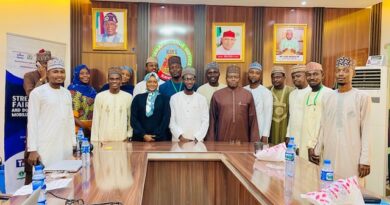Governor Namadi’s Visionary Investment in Kano DisCo Yielding Results
When the Jigawa State Government announced in January 2024 that it would invest ₦4 billion into Future Energies Africa (FEA) to acquire a 2.5 percent stake in the Kano Electricity Distribution Company (KEDCO), many Nigerians were skeptical.
The move broke from the traditional playbook of state governments, which have long limited their involvement in the power sector to donations of transformers and short-term palliatives. But 18 months later, Governor Umar Namadi’s bet is showing clear signs of paying off, both in returns and results.
On July 7, 2025, the State Executive Council approved the second tranche payment of ₦1 billion to FEA, reinforcing Jigawa’s long-term commitment to the partnership. The investment, the first of its kind by any Nigerian state since the 2013 power sector privatisation, is already producing tangible outcomes in terms of electricity access, infrastructure upgrades, and fiscal returns.
A Strategic, Unorthodox Investment:
The context behind Jigawa’s bold move is compelling. FEA had just acquired KEDCO’s majority shareholding from Fidelity Bank after the latter placed the electricity distributor in receivership due to poor performance by the previous core investors. The opportunity was ripe for a reset, and Namadi seized it, not just to secure power supply improvements but to ensure Jigawa had a financial stake in the success of the region’s power distribution.
Crucially, the investment deal did more than buy equity. It required FEA to commit to matching, and even exceeding, Jigawa’s ₦4 billion investment with infrastructure developments targeted specifically at the state. Sources in the State House say Namadi was adamant that the funds should yield measurable returns, not just political goodwill.
Performance rebound – KEDCO Emerges as Leader:
KEDCO, which previously lagged behind its peers in operational and financial performance, has undergone a dramatic transformation under FEA’s stewardship. When FEA took over, the company’s market remittance rate was a dismal 59 percent. Today, according to the Nigerian Electricity Regulatory Commission (NERC)’s Q1 2025 performance report, KEDCO is the best-performing DISCO in Northern Nigeria, with a remittance performance above 100 percent.
The turnaround is credited to a new governance structure led by the FEA-appointed board, working closely with the Bureau of Public Enterprises and state governments in the KEDCO franchise area — namely Kano, Katsina, and Jigawa. Improvements in billing and collection efficiencies have followed, significantly reducing commercial losses.
Powering Jigawa – From Urban Hubs to Rural Grids:
Even more remarkable are the on-ground infrastructure developments now reshaping Jigawa’s power landscape. FEA’s infrastructure commitments include up to 10MW of interconnected solar mini-grids in key cities, including Dutse, Gumel, Hadejia, Kafin Hausa, Kazaure, and Ringim.
These projects are being implemented through FEA’s renewable energy subsidiary, Bagaja Renewables, which previously constructed Nigeria’s largest interconnected mini-grid in Zawaciki, Kano. The flagship 500kW mini-grid in Kafin Hausa is nearing 95% completion, built at an estimated cost of ₦950 million. Additionally, the once-damaged second substation in Dutse has been fully repaired and brought back online, restoring redundancy and minimizing blackout risk in the capital — a project that cost nearly ₦200 million.
According to Sani Bala Sani, spokesperson for KEDCO, the next wave of mini-grids will focus on Hadejia and the Maigatari Free Trade Zone in Gumel. “We estimate to spend an incremental $3 million on these projects,” Bala said. “Our investors are bullish about the sector, and we’re actively engaging the Jigawa State Government on additional projects — including one to replace the Gagarawa-Taura-Ringim line, now under federal supervision.”
In a separate milestone, FEA recently completed a 39-kilometre distribution line delivering Band A electricity supply to the Dawanau International Grain Market, a major agro-trade hub. This line is expected to boost industrial activity in the region and aligns with Jigawa’s larger agro-industrial ambitions.
A Model for Energy Reform:
Governor Namadi’s “Agenda for Greater Jigawa” is increasingly being recognized as a template for pragmatic and forward-thinking energy policy at the subnational level. By choosing to invest strategically, rather than merely spending, Jigawa is positioning itself as a pioneer in driving inclusive electrification and sustainable industrial growth.
The governor’s approach also breaks with the traditional donor-recipient dynamic that has long defined state-DISCO relationships in Nigeria. Rather than providing infrastructure on behalf of the utility, Jigawa is shaping utility investment priorities through an ownership lens, and the results are speaking for themselves.
The Road Ahead:
While the full dividends of Jigawa’s investment in KEDCO and FEA are yet to be realised, early indicators suggest a partnership built on accountability, innovation, and mutual benefit. The alignment of public capital with private sector efficiency appears to be catalyzing a virtuous cycle of growth.
Challenges remain, especially as the federal government continues to recalibrate its role in power sector development. However, Jigawa’s proactive engagement and insistence on a structured, ROI-driven model have provided the state with both leverage and learning.
As Nigeria continues to grapple with widespread electricity shortfalls, Jigawa’s success offers a compelling case study and a challenge to other states to rethink their approach to power sector participation. Governor Namadi’s gamble is not only yielding returns; it is changing the conversation on how to build a reliable, sustainable energy future in Nigeria.





